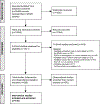Social determinants of health and US cancer screening interventions: A systematic review
- PMID: 37329257
- PMCID: PMC10529377
- DOI: 10.3322/caac.21801
Social determinants of health and US cancer screening interventions: A systematic review
Abstract
There remains a need to synthesize linkages between social determinants of health (SDOH) and cancer screening to reduce persistent inequities contributing to the US cancer burden. The authors conducted a systematic review of US-based breast, cervical, colorectal, and lung cancer screening intervention studies to summarize how SDOH have been considered in interventions and relationships between SDOH and screening. Five databases were searched for peer-reviewed research articles published in English between 2010 and 2021. The Covidence software platform was used to screen articles and extract data using a standardized template. Data items included study and intervention characteristics, SDOH intervention components and measures, and screening outcomes. The findings were summarized using descriptive statistics and narratives. The review included 144 studies among diverse population groups. SDOH interventions increased screening rates overall by a median of 8.4 percentage points (interquartile interval, 1.8-18.8 percentage points). The objective of most interventions was to increase community demand (90.3%) and access (84.0%) to screening. SDOH interventions related to health care access and quality were most prevalent (227 unique intervention components). Other SDOH, including educational, social/community, environmental, and economic factors, were less common (90, 52, 21, and zero intervention components, respectively). Studies that included analyses of health policy, access to care, and lower costs yielded the largest proportions of favorable associations with screening outcomes. SDOH were predominantly measured at the individual level. This review describes how SDOH have been considered in the design and evaluation of cancer screening interventions and effect sizes for SDOH interventions. Findings may guide future intervention and implementation research aiming to reduce US screening inequities.
Keywords: United States; cancer screening; early detection of cancer; health equity; implementation science; social determinants of health.
© 2023 The Authors. CA: A Cancer Journal for Clinicians published by Wiley Periodicals LLC on behalf of American Cancer Society.
Conflict of interest statement
Figures



References
-
- American Association for Cancer Research. AACR Cancer Disparities Progress Report; 2022. Accessed September 30, 2022. http://www.cancerdisparitiesprogressreport.org/ - PubMed
-
- Cancer Recommendations. U.S. Preventive Services Task Force (USPSTF). Accessed April 4, 2023. https://uspreventiveservicestaskforce.org/uspstf/topic_search_results?ca... - PubMed
-
- Community Preventive Services Task Force Findings: Cancer. The Community Guide. Accessed April 4, 2023. https://www.thecommunityguide.org/topics/cancer.html
Publication types
MeSH terms
Grants and funding
LinkOut - more resources
Full Text Sources
Medical

